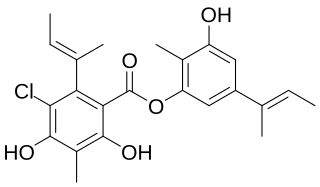Related Research Articles
1-Nonacosanol is a straight-chain aliphatic 29-carbon primary fatty alcohol. It is found in a variety of plants including sisal.
Penicillium turbatum is an anamorph species of fungus in the genus Penicillium which was isolated from Taxus baccata. Penicillium turbatum produces pipolythiopiperazinedione-antibiotics, hyalodendrin A and hadacitin.
Streptomyces aculeolatus is a bacterium species from the genus of Streptomyces which has been isolated from soil from the Tottori prefecture in Japan. Streptomyces aculeolatus produces naphthablin.
Streptomyces bacillaris is a bacterium species from the genus of Streptomyces which has been isolated from forest soil in Oregon in the United States.
Streptomyces canarius is a bacterium species from the genus of Streptomyces. Streptomyces canarius produces saphenamycin and canarius.
Streptomyces candidus is a bacterium species from the genus of Streptomyces which has been isolated from soil in Russia. Streptomyces candidus produces lemonomycin, enterocin, pyrazofurin and avoparcin.
Streptomyces celluloflavus is a bacterium species from the genus of Streptomyces which has been isolated from soil in Japan. Streptomyces celluloflavus produces aureothricin and has the ability to degrade cellulose.
Streptomyces cellulosae is a bacterium species from the genus of Streptomyces which has been isolated from garden soil. Streptomyces cellulosae produces fungichromin.
Streptomyces griseosporeus is a bacterium species from the genus of Streptomyces. Streptomyces griseosporeus produces taitomycin, 2-amino-4-hydroxypentanonic acid and liposidomycins.
Streptomyces kasugaensis is a bacterium species from the genus of Streptomyces which has been isolated from soil from the city Nara in Japan. Streptomyces kasugaensis produces kasugamycin and thiolutin.
Streptomyces luteogriseus is a bacterium species from the genus of Streptomyces. Streptomyces luteogriseus produces peliomycin and (+)-(S)-streptonol A.
Streptomyces mobaraensis is a spore forming bacterium species from the genus of Streptomyces. Streptomyces mobaraensis produces bleomycin, detoxin, piericidin A, piericidin B, reticulol and transglutaminase. Streptomyces mobaraensis is used in the food industry to produce transglutaminase to texture meat and fish products.
The Lachnospiraceae are a family of obligately anaerobic, variably spore-forming bacteria in the order Eubacteriales that ferment diverse plant polysaccharides to short-chain fatty acids and alcohols (ethanol). These bacteria are among the most abundant taxa in the rumen and the human gut microbiota. Members of this family may protect against colon cancer in humans by producing butyric acid. Lachnospiraceae have been found to contribute to diabetes in genetically susceptible (ob/ob) germ-free mice.
Streptomyces purpureus is a bacterium species from the genus of Streptomyces which has been isolated from soil. Streptomyces purpureus produces chloramphenicol, bottromycin and fradicin.
Calditerrivibrio is a genus of bacteria from the family of Deferribacteraceae with one known species. Calditerrivibrio nitroreducens has been isolated from a hot spring from Yumata in Japan.
Geovibrio ferrireducens is a Gram-negative, Fe(III)-reducing, obligately anaerobic and motile bacterium from the genus of Geovibrio.

Guisinol is an antibacterial depside with the molecular formula C23H25ClO5 that has been isolated from the fungus Aspergillus unguis.
Aigialus parvus is a fungus species of the genus of Aigialus. Aigialus parvus produces a number of bioactive compounds like Aigialomycin B, Aigialomycin D, Aigialospirol and Aigialone.

Aigialomycin D is a macrolide antibiotic which is produced by the fungi Aigialus parvus. Aigialomycin D is a resorcylic acid lactone and has the molecular formula C18H22O6. Preliminary studies found that aigialomycin D is a protein kinase inhibitor with anti-tumor activity. Aigialomycin D has antimalarial activity.

Aureoverticillactam is an antifungal macrocyclic lactam with the molecular formula C28H39NO4 which is produced by the marine bacterium Streptomyces aureoverticillatus. Aureoverticillactam has also cytotoxic activity.
References
- 1 2 Parte, A.C. "Haliangium". LPSN .
- 1 2 "Haliangium". www.uniprot.org.
- ↑ Parker, Charles Thomas; Garrity, George M (2020). Parker, Charles Thomas; Garrity, George M (eds.). "Nomenclature Abstract for Haliangium Fudou et al. 2002". The NamesforLife Abstracts. doi:10.1601/nm.3777.
- ↑ Colegate, Steven M.; Molyneux, Russell J. (2007). Bioactive Natural Products: Detection, Isolation, and Structural Determination, Second Edition. CRC Press. ISBN 9781420006889.
- ↑ Blunt, John W.; Munro, Murray H. G. (2007). Dictionary of Marine Natural Products with CD-ROM. CRC Press. ISBN 9780849382178.
- ↑ Gal, Yves Le; Ulber, Roland (2005). Marine Biotechnology II. Springer Science & Business Media. ISBN 9783540256694.